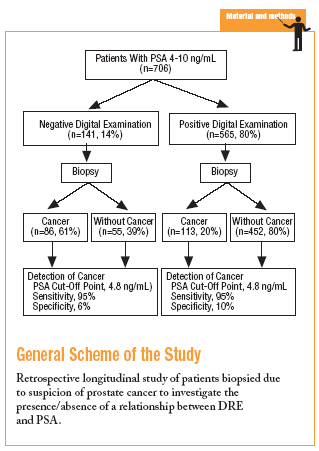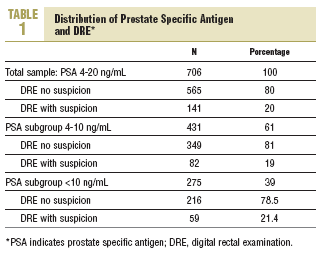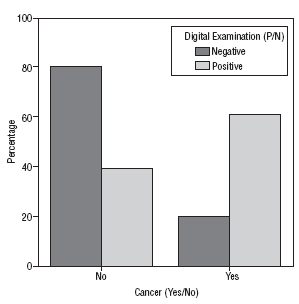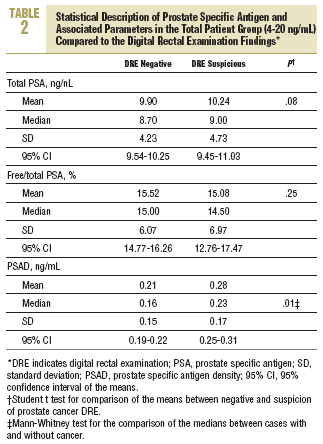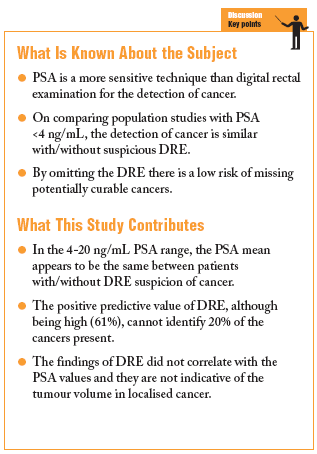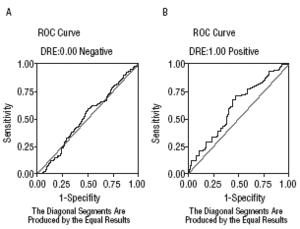of prostatic cancer by biopsy. Results. With a detection of cancer of 28.2%, there were no statistically significant differences in the PSA or free/total PSA ratio mean values between patients with or without suspicious DRE. The analysis using ROC curves (with a 95% confidence interval) between both groups of patients found the same sensitivity of 95% with a similar specificity of 6% and 10%, respectively, for a PSA of 4.8 ng/mL. Conclusions. In the PSA range of 4.1-20 ng/mL, the findings of DRE appeared as a variable unrelated to the increase in PSA or the free/total PSA ratio and, therefore are not indicative of a lesser or greater volume of a tumour producing PSA. The performing of this examination could be considered as optional.
Introduction
Some authors recognise that prostate specific antigen (PSA) is the most important tumour marker in the wide field of the study of medicine. In fact, the measurement of PSA to detect the presence of prostate cancer is used universally. However, the clinical value of PSA continues to be controversial since, currently, in asymptomatic patients the majority of scientific organisations (including semFYC [Spanish Society of Family and Community Medicine]) through its PAPPS (Programme of Preventive Activities and Health Promotion) group do not recommend prostate cancer screening. The inability of this test on its own to distinguish between benign diseases of the prostate and localised tumours have given rise to unnecessary prostate biopsies in a large number of men and, in many cases, even repeating these biopsies an indeterminate number of times, with all the costs, both financially and emotionally, which this involves. For this reason, although values of PSA between 4 ng/mL and 20 ng/mL are associated with the possibility of having a cancer confined to one organ and, therefore, potentially curable, it must not be forgotten that only a quarter of these cases will have a cancer2 and, on the other hand, values <4 ng/mL do not necessarily exclude the possibility of having this neoplasia, therefore this potential for false negatives also has to be taken into account.3
Different studies have been carried out to determine if the combination of digital rectal examination (DRE) along with PSA measurement is a more useful way of increasing the detection of prostate cancer.4-7 In primary care, the reliability of this examination is hampered by the fact that the mean number of prostate consultations is only 3.92 per week, according to a questionnaire sent to 15 000 primary care doctors by the Spanish Prostatic Health Council,8 with hardly any data on the inter-observer or intra-observer reproducibility of this examination. With the sole use of DRE as an investigational method of prostate cancer, 67% to 88% of these types of neoplasias show up as apparently localised cancer at the time of diagnosis,9,10 but in reality this figure is much lower in the final histopathology analysis of operated patients.11 In the study by the American College of Surgeons in 1999, almost 60% of the males who took part had an apparently localised cancer in a clinical stage at the time of diagnosis.12 In another study13 it has been reported that only 33% of the males studied in the era before PSA with a cancer detected using DRE had a histologically localised disease in the prostate gland. The measurement of PSA as a tumour marker has given rise to a spectacular change in the detection of prostate cancer and has established a reasonable doubt on continuing to systematically use DRE in clinical practice, and which is the objective of this study.
Methods
The study is designed as a retrospective evaluation of diagnostic tests: data was collected from 706 patients, suspected of having prostate cancer with a PSA ranging from 4.1 ng/mL to 20.0 ng/mL, sent from the primary care clinic. These cases were attended to by a reference specialist during the period November 2002-February 2004 in the Gregorio Marañón Hospital, and an ultrasound was performed with random sextant prostate biopsies. The inclusion criteria were: >40 years and a biopsy with a conclusive result. The exclusion criteria were all the situations capable of interfering with the baseline PSA value and previous prostate surgery. DRE, performed in all the cases, was categorised as normal, or suspicious of cancer by the same urologist who carried out the ultrasound. The prostate glands which were only found to be enlarged were not classified as abnormal, in accordance with the aims of this study.
The measurement of PSA in the serum of the patients was carried out, before the biopsy, using an equimolar immunochemiluminescent method (Immulite 2000 PSA, Los Angeles, USA). The free/total PSA fraction was analysed using the solid phase, 2-site sequential chemiluminescent immunometric assay. Additionally, the PSAD (prostate specific antigen density) was measured in all patients by measuring the prostatic volume in all cases before performing the biopsy. The number of biopsies was 6 in each case, independent of the prostate volume present, with the aim of being able to uniformly evaluate the results obtained.
Descriptive statistical analysis was performed on the measured variables, for which the mean, median, and standard deviation was used for the quantitative variables and the absolute and percentage frequencies for the categorical or qualitative variables. The discriminatory power of PSA for the results benignancy or malignancy of the biopsy according to the data from the DRE were evaluated using ROC (receiver operating characteristic) curves, which allowed cut-off points capable of reaching a sensitivity of 95% to be set, and its corresponding specificity was also evaluated. The statistical comparisons between cancer and benign prostatic hyperplasia were performed using the Student t test and the Mann-Whitney test, considering values of P<.05 as statistically significant.
Results
From the total patients studied (n=706), the presence of cancer was detected in 199 cases (28.2%). The distribution of total PSA values and the findings of DRE are shown in Table 1. 61.0% of the sample (431/706) had a PSA value between 4 ng/mL and 10 ng/mL. The DRE was suggestive of being benign in 80% of cases (565/706), and a DRE with suspicion of malignancy was obtained in 20% (141/706). These percentages were almost identical (81% and 19%) in the subgroup with PSA values of 4 ng/mL to 10 ng/mL in which the overlap between benign prostatic hyperplasia (BHP) and cancer is normally more frequent.
On analysing the total number of diagnosed cancers (199 adenocarcinomas), the digital examination with suspicion of malignancy found in 141 patients, confirmed this diagnosis in 86 cases (61%) (positive predictive value of the test), but cancer will only be detected regardless of the suspicion in rectal examination in 55 cases (39%). The DRE, apparently normal in 565 patients, did not detect the cancer actually present in 113 cases (20%) and corresponds to an absence of cancer in 452 cases (80%) (negative predictive value). This difference between the results of the DRE and the final diagnosis was significantly different (P<.0001), with a sensitivity of 43.2% and a specificity of 89.2% (Figure 1). In the PSA range of 4.1 ng/mL to 20.0 ng/mL studied, the PSA acquired a better specificity (56%) at a cut-off value of 9 ng/mL, but with a sensitivity of only 52%. The analysis of free/total PSA showed an apparent optimal cut-off point at 25%, with a sensitivity of 93%, losing only 7% of the cancers, but with a specifity of only 6%. The PSAD in the standardised cut-off point of 0.15 ng/mL obtained a sensitivity of 82% and a specificity of 45%.
Fig. 1. Descriptive diagram of the percentage cancer detection according to the findings of digital rectal examination.
The descriptive statistics values for PSA, the free/total PSA ratio and the PSAD compared to DRE are shown in Table 2. When the total sample of all the included subjects is evaluated, there was no statistically significant difference between the mean value for PSA between patients with a digital examination negative for cancer (9.9 ng/mL) and those in whom cancer was suspected (10.2 ng/mL), and the mean value obtained for the free/total PSA ratio was similar between normal digital examination (15.5%) and those who had a digital examination with a suspicion of cancer (15.0%).
The ROC curves of the PSA in patients with digital examination indicative of benignancy and in the cases of digital examination with a suspicion of neoplasia were analysed. The areas under the curve obtained in patients with normal or abnormal DRE were 0.516 and 0.608, respectively, with overlapping 95% confidence interval values. The cut-off point required to obtain 95% sensitivity was the same in both groups (4.8 ng/mL) with a specificity of 6% and 10%, which meant that the information contributed by DRE did not have a significant impact on the results obtained over the detection of cancer using PSA (Figure 2).
Fig. 2. Receiver operating characteristics (ROC) curves of prostate specific antigen for the detection of cancer A: in cases with negative digital examination (AUC=0.516). B: in cases with suspicious digital examination (AUC=0.704).
Discussion
The debate on whether biopsy has to be recommended in males with a DRE with no suspicion of cancer and a PSA between 4 ng/mL and 10 ng/mL, the common range for BPH and localised cancer, has been the subject of controversy for a long time. For a decade it was accepted, with an almost total consensus, that a prostate biopsy had to be indicated when the DRE was suspicious or the PSA was >10 ng/mL. However, since the publication of the multicentre study led by Catalona et al,7 carried out on 6630 males, in 18% of those who had a biopsy performed, this idea had to change, since in those cases with PSA values of 4 ng/mL and 10 ng/mL with a digital rectal examination not indicative of malignancy 21% were found with cancer, a similar percentage to that found in the cases with a suspicious digital examination (21%).
During all this process it is evident that the primary care doctor plays a fundamental role. Some publications14 show that, in certain health environments outside our country, the family doctor systematically carries out the DRE in 84% of patients >50 years who consult with micturation symptoms of the lower urinary tract, and the PSA is also frequently measured in this group of patients.
Thus, in a large multicentre study carried out in our country with 587 biopsied patients,15 the total PSA was shown to be a more sensitive technique for the detection of cancer than a DRE only, since of the 131 tumours detected according to the PSA value, 41 (31.2%) would not have been detected if DRE had been the only criteria to indicate biopsy. However, the positive predictor value of digital examination was 43.7%, higher than the PSA (24% for a cut-off of 4 ng/mL). Only a PSA value >10 ng/mL in the aforementioned study had a positive predictive value similar to digital examination (46.2%). This increased positive predictive value for digital examination contrasts with data published by other athors,5,13,16 who obtained a positive predictive value of 22%-39%. Thus, Benson et al17 mention 46.3% and Babaian et al,18 51%, and a better positive predictive value with the combination of the 2 parameters being quoted in the majority of series reviewed.5,18
In a study of prostate biopsies it was found that when the palpable nodule in the DRE was unilateral, the probability of finding a positive biopsy was similar, in the side supposedly affect as well as in the other side,19 concluding that the detection of these cancers could be due to chance. As regards studies carried out on large population groups with PSA>4 ng/mL, in the Prostate Cancer Prevention Trial,20 which studied 2950 patients with a negative DRE and a biopsy performed on all of them (with a PSA in that range it is considered "normal"), as well as in the study carried out by Carvahal et al21 in 2703 males with a DRE with a suspicion of cancer and a PSA<4 ng/mL, they found fairly similar rates of cancer detection (15.2% and 13.%, respectively).
As regards the PSA value in the 4-10 ng/mL range to detect supposedly localised, non disseminated cancer within the prostate, there are also unresolved doubts. Thus, in an anatomical study on surgical samples from radical prostatectomies,22 the levels of PSA could not be associated with tumour volume, but only with the prostate weight.
Thus, although it is admitted that prostate screening which does not include DRE has a low risk of missing potentially curable cancers,23 it is also accepted that cases with a normal PSA detected by palpation of a suspicious nodule could also be detected by a increase in PSA, observable in follow-up programs. On this basis and taking into account that globally PSA enables the detection of cancer in a greater number and earlier than DRE, the 3rd International Clinic on Prostate Cancer (2003) stated that the real value of rectal examination of the prostate was currently without definition.24
As a conclusion, it could be stated that, although digital examination has a good positive predictive value for the diagnosis of cancer in the present study, its systematic carrying out does not seem to be of great use. The performing of biopsies from a PSA value of 2.5 ng/mL, instead of the more commonly used 4 ng/mL, could enable the detection of cancer in the earlier stages and, therefore, potentially curable. However, given the natural history of the disease itself, we are not going to know in reality, how many of those could benefit from this diagnosis. The findings of DRE did not correlate with PSA levels and they do not seem to be an adequate indicator of the tumour volume in localised cancer stages.







